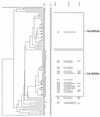Comparative molecular analysis of community- or hospital-acquired methicillin-resistant Staphylococcus aureus
- PMID: 12499191
- PMCID: PMC149027
- DOI: 10.1128/AAC.47.1.196-203.2003
Comparative molecular analysis of community- or hospital-acquired methicillin-resistant Staphylococcus aureus
Abstract
Community-acquired methicillin-resistant Staphylococcus aureus (CA-MRSA) is a growing public health concern that has been associated with pediatric fatalities. It is hypothesized that the evolution of CA-MRSA is a recent event due to the acquisition of mec DNA by previously methicillin-susceptible strains that circulated in the community. This study investigated the genetic relatedness between CA-MRSA, hospital-associated MRSA (HA-MRSA), and nonmenstrual toxic shock syndrome (nmTSS) isolates. Thirty-one of 32 CA-MRSA isolates were highly related as determined by pulsed-field gel electrophoresis and spa typing yet were distinguishable from 32 HA-MRSA strains. The 31 related CA-MRSA isolates produced either staphylococcal enterotoxin B (n = 5) or C (n = 26), and none made TSS toxin 1. All CA-MRSA isolates tested contained a type IV staphylococcal cassette chromosome mec (SCCmec) element. In comparison, none of the HA-MRSA isolates (n = 32) expressed the three superantigens. Antibiotic susceptibility patterns were different between the CA-MRSA and HA-MRSA isolates; CA-MRSA was typically resistant only to beta-lactam antibiotics. Six of twenty-one nmTSS isolates were indistinguishable or highly related to the CA-MRSA isolates. MnCop, an nmTSS isolate obtained in Alabama in 1986, was highly related to the CA-MRSA isolates except that it did not contain an SCCmec element. These data suggest that CA-MRSA strains may represent a new acquisition of SCCmec DNA in a previously susceptible genetic background that was capable of causing nmTSS. CA-MRSA poses a serious health risk not only because it is resistant to the antibiotics of choice for community-acquired staphylococcal infections but also because of its ability to cause nmTSS via superantigen production.
Figures



References
-
- Baba, T., F. Takeuchi, M. Kuroda, H. Yuzawa, K. Aoki, A. Oguchi, Y. Nagai, N. Iwama, K. Asano, T. Naimi, H. Kuroda, L. Cui, K. Yamamoto, and K. Hiramatsu. 2002. Genome and virulence determinants of high virulence community-acquired MRSA. Lancet 359:1819-1827. - PubMed
-
- Bohach, G. A., D. J. Fast, R. D. Nelson, and P. M. Schlievert. 1990. Staphylococcal and streptococcal pyrogenic toxins involved in toxic shock syndrome and related illnesses. Crit. Rev. Microbiol. 17:251-272. - PubMed
-
- Bohach, G. A., and P. M. Schlievert. 1987. Nucleotide sequence of the staphylococcal enterotoxin C1 gene and relatedness to other pyrogenic toxin genes. Mol. Gen. Genet. 209:15-20. - PubMed
-
- Centers for Disease Control and Prevention. 1999. Four pediatric deaths from community-acquired methicillin-resistant Staphylococcus aureus—Minnesota and North Dakota, 1997-1999. Morb. Mortal. Wkly. Rep. 48:707-710. - PubMed
MeSH terms
LinkOut - more resources
Full Text Sources
Other Literature Sources

